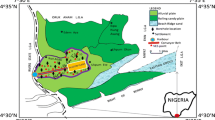Conclusions
-
1.
Hydrochemical methods of investigating the seepage flow under conditions of the Irkutsk hydrostation should be used in combination with traditional methods of observing the condition of the structures.
-
2.
As indicators of the seepage flows and subsurface waters it is possible to use, along with mineralization of the water, the content in water of C1− ions and the sum of the derivatives of carbonic acid ∑C02, which in certain cases give a more accurate idea about the seepage flow in the foundation when determining the effect of water on concrete of the structures and grout curtain.
-
3.
Having distributed the content of the indicator (total ions, Cl−, ∑CO2) in the piezometers along the equipotential lines of the seepage flow net, we can obtain a clear picture of the distribution of seepage flows and subsurface waters in the foundation and body of the structures. It is necessary to note that the seepage flow net obtained by calculation or on the EHDA instrument does not always correspond to the actual picture of seepage, which somewhat reduces the accuracy of the proposed method.
-
4.
The preliminary conclusions about the mechanism of interaction of the seepage flow with concrete of structures require further refinement by setting up broader hydrochemical investigations of seepage, including seepage through cracks in the concrete.
Similar content being viewed by others
Literature cited
A. Ya. Kovalev, A Giant on the Angara [in Russian], Izd. Lit. Stroit. Arkhitek., Moscow (1970).
S. N. Moiseev, Construction of the Irkutsk Hydroelectric Station on the Angara [in Russian], Gosénergoizdat, Moscow (1959).
O. A. Alekin, Chemical Analysis of Land Waters [in Russian], Gidrometeoizdat, Moscow (1954).
P. R. Taube and A. G. Baranova, Laboratory Manual on Water Chemistry [in Russian], Vysshaya Shkola, Moscow (1971).
M. D. Nikolaeva, Hydrochemical Characteristics of the Irkutsk Reservoir [in Russian], Gidrometeoizdat, Leningrad (1980).
O. A. Alekin, Principles of Hydrochemistry [in Russian], Gidrometeoizdat, Moscow (1970).
P. F. Bochkarev, M. D. Nikolaeva, and N. I. Sitnik, “Hydrochemical characteristics of surface waters,” in: Surface Water Resources of the USSR [in Russian], Vol. 16, Gidrometeoizdat, Leningrad (1972).
I. E. Orlov, Corrosive Properties of Natural Waters [in Russian], ONTI, Moscow (1932).
M. N. Furman and R. E. Litvinova, “Study of the strength and stability of hydrotechnical concrete with consideration of leaching during seepage,” Izv. VNIIG,49 (1953).
Additional information
Translated from Gidrotekhnicheskoe Stroitel'stvo, No. 4, pp. 14–18, April, 1982.
Rights and permissions
About this article
Cite this article
Nikolaeva, M.D., Kalenov, V.P. Hydrochemical methods in investigation of seepage in the foundation of structures of the Irkutsk hydroelectric station. Hydrotechnical Construction 16, 203–209 (1982). https://doi.org/10.1007/BF01427168
Issue Date:
DOI: https://doi.org/10.1007/BF01427168




